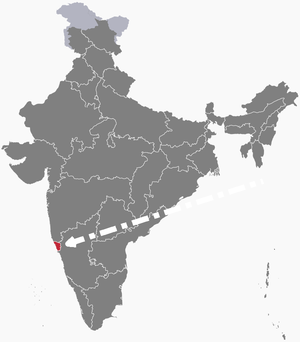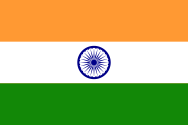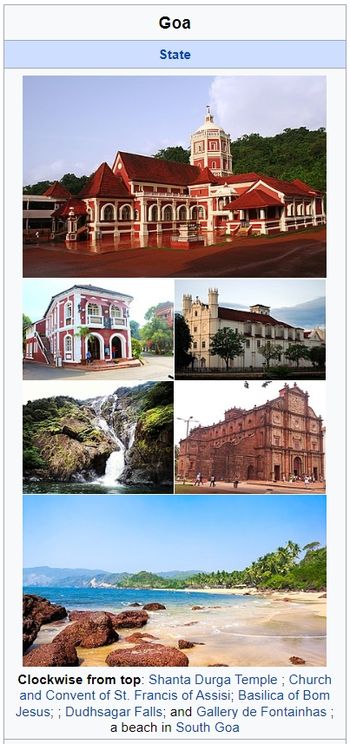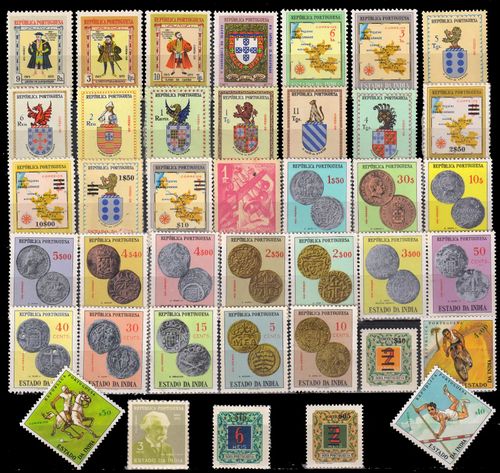Goa
| Goa |
|
English, and Portuguese |
Source information is available at [ Sources ] |
Goa (Konkani pronunciation: [ɡõːj], Portuguese: [ˈɡoɐ] ⓘ) is a state on the southwestern coast of India within the Konkan region, geographically separated from the Deccan highlands by the Western Ghats. It is bound by the Indian states of Maharashtra to the north, and Karnataka to the east and south, with the Arabian Sea in the west. It is India's smallest state by area and fourth-smallest by population. Goa has the highest GDP per capita among all Indian states, two and a half times as high as the GDP per capita of the country as a whole. The Eleventh Finance Commission of India named Goa the best-placed state because of its infrastructure, and India's National Commission on Population rated it as having the best quality of life in India (based on the commission's "12 Indicators"). It is the second-highest ranking among Indian states in the human development index.
History
Panaji is the state's capital, while Vasco da Gama is its largest city. The historic city of Margão in Goa still exhibits the cultural influence of the Portuguese, who first voyaged to the subcontinent in the early 16th century as merchants, and conquered it soon thereafter, whereupon Goa became an overseas territory of the Portuguese Empire, part of what was then known as Portuguese India, and remained as such for about 456 years until it was annexed by India in 1961. Goa's official language, which is spoken by a majority of its inhabitants, is Konkani.
Goa is visited by large numbers of international and domestic tourists each year because of its white-sand beaches, active nightlife, places of worship, and World Heritage-listed architecture. It also has rich flora and fauna because it lies very close to the North Western Ghats rainforests, one of the rare biodiversity hotspots of the world.
Etymology
After the Bahmani-Bijapuri city of Goa was captured by Afonso de Albuquerque in AD 1510, and made the capital of the Estado da Índia, the city gave its name to the contiguous territories.
The origin of the city name "Goa" is unclear. In ancient literature, Goa was known by many names, such as Gomanchala, Gopakapattana, Gopakapattam, Gopakapuri, Govapuri, Govem, and Gomantak. Other historical names for Goa are Sindapur, Sandabur, and Mahassapatam.
Robin's personal observations
- Growing up, postage stamps from colonial Goa were beautiful and very collectible.
Research has shown that Goa has beautiful beaches and a warm climate - a summer vacation all year long.
- During the Portuguese world exploration, they established Portuguese-Indian Trade ports in the same manner as the established Portuguese-Indian Trade ports like Macau in China. Portuguese buildings, forts, and churches are present throughout the country.
- During WWII, Goa was a neutral country with warships from many warring countries making port calls. A German cargo ship was sending ships-movements to German U-boats in the area. "Operation Creek" trained a group of British ex-patriots in clandestine warfare to board the German cargo ship, Ehrenfels, appearing to be drunken party-goers, to take over the ship and scuttle it. This story was made into the movie, The Sea Wolves
- Portuguese is no longer the prime language, but it is still spoken in Goa.
Spanking and Spanking Art in Goa
( We have no further information from SAOTK as of April, 2022 )
Prostitution in Goa
( We have no further information from Wikipedia as of April, 2022 )
External links
- Wikipedia article: Goa
Chat rooms • What links here • Copyright info • Contact information • Category:Root



